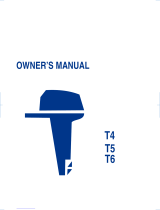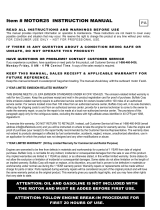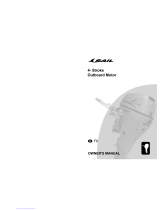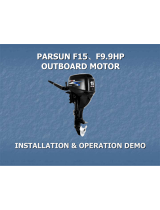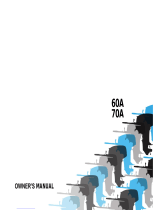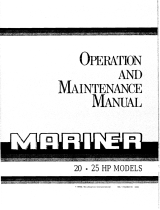Page is loading ...

Read this manual carefully before operating this
outboard motor.
OWNER’S MANUAL
F30
F40
LIT-18626-12-39
6BG-28199-3F-E0
6BG-9-3F-E0.book 1 ページ 2018年11月1日 木曜日 午後5時1分
©2020 Yamaha Motor Corporation

EMU25065
This product
can expose you to chemicals
including engine exhaust, which
is known to the State of California
to cause cancer, and carbon
monoxide, which is known to the
State of California to cause birth
defects or other reproductive harm.
For more information go to
www.P65Warnings.ca.gov.
WARNING:
Ce produit peut vous exposer à des produits chimiques y compris aux
gaz d’échappement, qui sont considérés par l’état de Californie comme
étant cancérigènes, et au monoxyde de carbone, qui est considéré par
l’état de Californie comme un facteur de malformations congénitales ou
d’autres troubles de la reproduction. Pour plus d’informations,
rendez-vous sur www.P65Warnings.ca.gov.
ZMU08844
Read this manual carefully before operating this outboard motor. Keep this
manual onboard in a waterproof bag when boating. This manual should stay
with the outboard motor if it is sold.
6BG-9-3F-E0.book 1 ページ 2018年11月1日 木曜日 午後5時1分
©2020 Yamaha Motor Corporation

Important manual information
EMU44141
To the owner
Thank you for selecting a Yamaha outboard
motor. This Owner’s Manual contains infor-
mation needed for proper operation, mainte-
nance and care. A thorough understanding
of these simple instructions will help you ob-
tain maximum enjoyment from your new
Yamaha. If you have any question about the
operation or maintenance of your outboard
motor, please consult a Yamaha dealer.
In this Owner’s Manual particularly important
information is distinguished in the following
ways.
: This is the safety alert symbol. It is
used to alert you to potential personal injury
hazards. Obey all safety messages that fol-
low this symbol to avoid possible injury or
death.
WARNING
EWM00782
A WARNING indicates a hazardous situa-
tion which, if not avoided, could result in
death or serious injury.
NOTICE
ECM00702
A NOTICE indicates special precautions
that must be taken to avoid damage to the
outboard motor or other property.
TIP:
A TIP provides key information to make pro-
cedures easier or clearer.
Yamaha continually seeks advancements in
product design and quality. Therefore, while
this manual contains the most current prod-
uct information available at the time of print-
ing, there may be minor discrepancies
between your machine and this manual. If
there is any question concerning this manu-
al, please consult your Yamaha dealer.
To ensure long product life, Yamaha recom-
mends that you use the product and perform
the specified periodic inspections and main-
tenance by correctly following the instruc-
tions in the owner’s manual. Any damage
resulting from neglect of these instructions is
not covered by warranty.
Some countries have laws or regulations re-
stricting users from taking the product out of
the country where it was purchased, and it
may be impossible to register the product in
the destination country. Additionally, the war-
ranty may not apply in certain regions. When
planning to take the product to another coun-
try, consult the dealer where the product was
purchased for further information.
If you purchased this outboard motor used,
see your Yamaha dealer to have it registered
in your name in Yamaha records.
TIP:
The F30A, F30HA, F30EHA, F40A, F40HA,
F40EHA and the standard accessories are
used as a base for the explanations and illus-
trations in this manual. Therefore some
items may not apply to every model.
EMU44152
F30, F40
OWNER’S MANUAL
©2019 by Yamaha Motor Co., Ltd.
1st Edition, November 2018
All rights reserved.
Any reprinting or unauthorized use
without the written permission of
Yamaha Motor Co., Ltd.
is expressly prohibited.
Printed in Japan
6BG-9-3F-E0.book 1 ページ 2018年11月1日 木曜日 午後5時1分
©2020 Yamaha Motor Corporation

Table of contents
Safety information............................. 1
Outboard motor safety .....................1
Propeller .............................................. 1
Rotating parts ...................................... 1
Hot parts.............................................. 1
Electric shock ...................................... 1
Power trim and tilt................................ 1
Engine shut-off cord (lanyard) ............. 1
Gasoline .............................................. 1
Gasoline exposure and spills .............. 2
Carbon monoxide ................................ 2
Modifications ....................................... 2
Boating safety ..................................2
Alcohol and drugs................................ 2
Personal flotation devices (PFDs) ....... 2
People in the water.............................. 2
Passengers ......................................... 2
Overloading ......................................... 2
Avoid collisions.................................... 3
Collisions with floating or submerged
objects.............................................. 3
Weather............................................... 3
Accident reporting ............................... 4
Boat education and training................. 4
Passenger training .............................. 4
Boating safety publications.................. 4
Laws and regulations .......................... 4
Boating organizations.......................4
Basic boating rules (Rules of the
road).............................................. 5
Steering and sailing rules and sound
signals.............................................. 5
Rules when encountering vessels....... 6
Other special situations ....................... 7
General information ........................ 10
Identification numbers record......... 10
Outboard motor serial number .......... 10
Key number ....................................... 10
Compliance mark label...................10
Read manuals and labels...............12
Warning labels .................................. 12
Engine data recording ....................14
Specifications and
requirements ................................... 15
Specifications................................. 15
Installation requirements................ 16
Boat horsepower rating ..................... 16
Mounting outboard motor .................. 16
Remote control requirements......... 16
Battery requirements...................... 17
Battery specifications ........................ 17
Propeller selection ......................... 17
Start-in-gear protection .................. 18
Engine oil requirements ................. 18
Fuel requirements.......................... 19
Gasoline ............................................ 19
Gasoline Additives............................. 20
Muddy or acidic water.................... 21
Anti-fouling paint ............................ 21
Outboard motor disposal
requirements............................... 22
Emergency equipment................... 22
Emission control information ......... 22
Star labels ......................................... 22
Components .................................... 24
Components diagram..................... 24
Optional items ................................... 25
Fuel tank (portable fuel tank)............. 25
Yamaha Security System (Y-COP) ... 27
Remote control box ........................... 27
Remote control lever ......................... 27
Neutral interlock trigger ..................... 28
Neutral throttle lever .......................... 28
Tiller handle ...................................... 28
Gear shift lever ................................. 28
Throttle grip ...................................... 29
Throttle indicator ............................... 29
Throttle friction adjuster..................... 29
Engine shut-off cord (lanyard) and
clip.................................................. 30
Engine stop button ........................... 30
Main switch........................................ 31
Steering friction adjuster.................... 31
6BG-9-3F-E0.book 1 ページ 2018年11月1日 木曜日 午後5時1分
©2020 Yamaha Motor Corporation

Table of contents
Power trim and tilt switch on remote
control or tiller handle..................... 32
Power trim and tilt switch on bottom
cowling ........................................... 32
Variable trolling RPM switches ......... 33
Trim tab with anode........................... 33
Tilt lock mechanism........................... 34
Tilt support knob................................ 34
Cowling lock lever ............................. 34
Flushing device ................................. 34
Fuel filter/Water separator................. 35
Alert indicator ................................... 35
Instruments and indicators ............ 36
Indicators ....................................... 36
Low oil pressure-alert indicator ......... 36
Overheat-alert indicator..................... 36
Digital tachometer .......................... 36
Tachometer ....................................... 37
Trim meter ......................................... 37
Hour meter ........................................ 37
Low oil pressure-alert indicator ......... 37
Overheat-alert indicator..................... 38
Digital speedometer ....................... 38
Speedometer..................................... 38
Fuel gauge ........................................ 38
Trip meter / Clock / Voltmeter............ 39
Fuel level-alert indicator .................... 40
Low battery voltage-alert indicator .... 40
6Y8 Multifunction meters................ 40
Engine control system.................... 44
Alert system ...................................44
Overheat alert.................................... 44
Low oil pressure alert ........................ 44
Installation ....................................... 46
Installation ......................................46
Mounting the outboard motor ............ 46
Operation ......................................... 48
First-time operation ........................ 48
Fill engine oil ..................................... 48
Breaking in engine............................. 48
Getting to know your boat ................. 48
Checks before starting engine ....... 48
Fuel level ........................................... 49
Remove the top cowling .................... 49
Fuel system ....................................... 49
Controls ............................................. 49
Engine shut-off cord (lanyard) ........... 50
Engine oil........................................... 50
Engine ............................................... 50
Flushing device ................................. 50
Install top cowling .............................. 51
Checking power trim and tilt
system............................................ 51
Battery ............................................... 52
Filling fuel....................................... 52
Operating engine ........................... 55
Sending fuel (portable tank) .............. 56
Starting engine .................................. 58
Checks after starting engine .......... 61
Cooling water .................................... 61
Warming up engine........................ 61
Manual start and electric start
models ........................................... 61
Checks after engine warm up ........ 61
Shifting .............................................. 61
Stop switches .................................... 61
Shifting........................................... 62
Stopping boat................................. 63
Trolling ........................................... 63
Adjusting trolling speed ..................... 63
Stopping engine............................. 64
Procedure.......................................... 64
Trimming outboard motor............... 66
Adjusting trim angle (Power trim and
tilt) .................................................. 67
Adjusting trim angle for hydro tilt
models ........................................... 67
Adjusting boat trim............................. 68
Tilting up and down........................ 69
Procedure for tilting up (hydro tilt
models) .......................................... 69
Procedure for tilting up (power trim
and tilt models)............................... 70
6BG-9-3F-E0.book 2 ページ 2018年11月1日 木曜日 午後5時1分
©2020 Yamaha Motor Corporation

Table of contents
Procedure for tilting down (hydro tilt
models) .......................................... 71
Procedure for tilting down (power
trim and tilt models)........................ 71
Shallow water ................................ 72
Hydro tilt models................................ 72
Power trim and tilt models ................. 73
Cruising in other conditions............ 74
Maintenance..................................... 75
Transporting and storing outboard
motor ........................................... 75
Storing outboard motor...................... 75
Conditioning and stabilizing
gasoline.......................................... 76
Procedure.......................................... 76
Lubrication......................................... 78
Cleaning and anticorrosion
measures ....................................... 78
Flushing power unit ........................... 79
Cleaning the outboard motor............. 79
Checking painted surface of
outboard motor............................... 80
Periodic maintenance..................... 80
Replacement parts ............................ 80
Maintenance interval guidelines ........ 80
Maintenance chart 1.......................... 82
Maintenance chart 2.......................... 84
Greasing............................................ 85
Cleaning and adjusting spark plug .... 86
Inspecting idle speed......................... 87
Changing engine oil........................... 87
Replacing the engine oil filter ............ 90
Why Yamalube .................................. 90
Inspecting wiring and connectors ...... 91
Checking propeller ............................ 91
Removing propeller ........................... 92
Installing propeller ............................. 92
Changing gear oil .............................. 93
Inspecting and replacing anode(s) .... 94
Checking battery (for electric start
models) .......................................... 95
Connecting the battery ...................... 96
Disconnecting the battery.................. 96
Trouble Recovery............................ 97
Troubleshooting ............................. 97
Temporary action in
emergency ................................ 100
Impact damage................................ 100
Replacing fuse................................. 100
Power trim and tilt will not
operate......................................... 101
Water separator-alert indicator
blinks while cruising ..................... 101
Starter will not operate .................... 103
Emergency starting engine.............. 104
Treatment of submerged motor ... 105
Consumer information (For
North America) .............................. 106
YAMAHA FOUR-STROKE
OUTBOARD MOTOR
THREE-YEAR LIMITED
WARRANTY ............................. 106
IMPORTANT WARRANTY
INFORMATION IF YOU USE
YOUR YAMAHA OUTSIDE
THE U.S.A. OR CANADA......... 108
INDEX ............................................. 109
6BG-9-3F-E0.book 3 ページ 2018年11月1日 木曜日 午後5時1分
©2020 Yamaha Motor Corporation

1
Safety information
EMU33623
Outboard motor safety
Observe these precautions at all times.
EMU36502
Propeller
People can be injured or killed if they come
in contact with the propeller. The propeller
can keep moving even when the motor is in
neutral, and sharp edges of the propeller can
cut even when stationary.
Stop the engine when a person is in the
water near you.
Keep people out of reach of the propeller,
even when the engine is off.
EMU40272
Rotating parts
Hands, feet, hair, jewelry, clothing, personal
flotation device (PFD) straps, etc., can be-
come entangled with internal rotating parts of
the engine, resulting in serious injury or
death.
Keep the top cowling in place whenever pos-
sible. Do not remove or replace the top cowl-
ing with the engine running.
Only operate the engine with the top cowling
removed according to the specific instruc-
tions in the manual. Keep hands, feet, hair,
jewelry, clothing, PFD straps, etc., away
from any exposed moving parts.
EMU33641
Hot parts
During and after operation, engine parts are
hot enough to cause burns. Avoid touching
any parts under the top cowling until the en-
gine has cooled.
EMU33651
Electric shock
Do not touch any electrical parts while start-
ing or operating the engine. They can cause
shock or electrocution.
EMU33662
Power trim and tilt
Body parts can be crushed between the mo-
tor and the clamp bracket when the motor is
trimmed or tilted. Keep body parts out of this
area at all times. Be sure no one is in this
area before operating the power trim and tilt
mechanism.
The power trim and tilt switches operate
even when the main switch is off. Keep peo-
ple away from the switches whenever work-
ing around the motor.
Never get under the lower unit while it is tilt-
ed, even when the tilt support lever is locked.
Severe injury could occur if the outboard mo-
tor accidentally falls.
EMU33672
Engine shut-off cord (lanyard)
Attach the engine shut-off cord so that the
engine stops if the operator falls overboard
or leaves the helm. This prevents the boat
from running away under power and leaving
people stranded, or running over people or
objects.
Always attach the engine shut-off cord to a
secure place on your clothing or your arm or
leg while operating. Do not remove it to leave
the helm while the boat is moving. Do not at-
tach the cord to clothing that could tear
loose, or route the cord where it could be-
come entangled, preventing it from function-
ing.
Do not route the cord where it is likely to be
accidentally pulled out. If the cord is pulled
during operation, the engine will shut off and
you will lose most steering control. The boat
could slow rapidly, throwing people and ob-
jects forward.
EMU33811
Gasoline
Gasoline and its vapors are highly flam-
mable and explosive. Always, refuel ac-
6BG-9-3F-E0.book 1 ページ 2018年11月1日 木曜日 午後5時1分
©2020 Yamaha Motor Corporation

Safety information
2
cording to the procedure on page 55 to
reduce the risk of fire and explosion.
EMU33821
Gasoline exposure and spills
Take care not to spill gasoline. If gasoline
spills, wipe it up immediately with dry rags.
Dispose of rags properly.
If any gasoline spills onto your skin, immedi-
ately wash with soap and water. Change
clothing if gasoline spills on it.
If you swallow gasoline, inhale a lot of gaso-
line vapor, or get gasoline in your eyes, get
immediate medical attention. Never siphon
fuel by mouth.
EMU33901
Carbon monoxide
This product emits exhaust gases which con-
tain carbon monoxide, a colorless, odorless
gas which may cause brain damage or death
when inhaled. Symptoms include nausea,
dizziness, and drowsiness. Keep cockpit and
cabin areas well ventilated. Avoid blocking
exhaust outlets.
EMU33781
Modifications
Do not attempt to modify this outboard mo-
tor. Modifications to your outboard motor
may reduce safety and reliability, and render
the outboard unsafe or illegal to use.
EMU33742
Boating safety
This section includes a few of the many im-
portant safety precautions that you should
follow when boating.
EMU33711
Alcohol and drugs
Never operate after drinking alcohol or taking
drugs. Intoxication is one of the most com-
mon factors contributing to boating fatalities.
EMU40281
Personal flotation devices (PFDs)
Have an approved PFD on board for every
occupant. Yamaha recommends that you
must wear a PFD whenever boating. At a
minimum, children and non-swimmers
should always wear PFDs, and everyone
should wear PFDs when there are potentially
hazardous boating conditions.
EMU33732
People in the water
Always watch carefully for people in the wa-
ter, such as swimmers, skiers, or divers,
whenever the engine is running. When
someone is in the water near the boat, shift
into neutral and stop the engine.
Stay away from swimming areas. Swimmers
can be hard to see.
The propeller can keep moving even when
the motor is in neutral. Stop the engine when
a person is in the water near you.
EMU33752
Passengers
Consult your boat manufacturer’s instruc-
tions for details about appropriate passenger
locations in your boat and be sure all pas-
sengers are positioned properly before ac-
celerating and when operating above an idle
speed. Standing or sitting in non-designated
locations may result in being thrown either
overboard or within the boat due to waves,
wakes, or sudden changes in speed or direc-
tion. Even when people are positioned prop-
erly, alert your passengers if you must make
any unusual maneuver. Always avoid jump-
ing waves or wakes.
EMU33763
Overloading
Do not overload the boat. Consult the boat
capacity plate or boat manufacturer for max-
imum weight and number of passengers. Be
sure that weight is properly distributed ac-
cording to the boat manufacturer’s instruc-
tions. Overloading or incorrect weight
distribution can compromise the boat’s han-
6BG-9-3F-E0.book 2 ページ 2018年11月1日 木曜日 午後5時1分
©2020 Yamaha Motor Corporation

Safety information
3
dling and lead to an accident, capsizing or
swamping.
EMU33773
Avoid collisions
Scan constantly for people, objects, and oth-
er boats. Be alert for conditions that limit your
visibility or block your vision of others.
Operate defensively at safe speeds and
keep a safe distance away from people, ob-
jects, and other boats.
Do not follow directly behind other boats or
waterskiers.
Avoid sharp turns or other maneuvers that
make it hard for others to avoid you or un-
derstand where you are going.
Avoid areas with submerged objects or
shallow water.
Ride within your limits and avoid aggres-
sive maneuvers to reduce the risk of loss
of control, ejection, and collision.
Take early action to avoid collisions. Re-
member, boats do not have brakes, and
stopping the engine or reducing throttle
can reduce the ability to steer. If you are
not sure that you can stop in time before
hitting an obstacle, apply throttle and turn
in another direction.
EMU48100
Collisions with floating or
submerged objects
If the outboard motor hits a floating object or
an obstacle in the water while cruising, the
following could occur:
The passengers and any loose equipment
or luggage could be thrown forward due to
the sudden deceleration.
Parts of the outboard motor could come
loose as a result of the impact and could
be thrown into the boat.
The boat or outboard motor could be dam-
aged as a result of the impact.
When you operate the boat in an area where
there might be floating objects or obstacles
in the water, be sure to adjust the trim angle
of the outboard motor, slow down, and oper-
ate carefully. For further information, see
page 72.
If the outboard motor hits a floating object or
an obstacle in the water, make sure that
there are no abnormalities with the boat and
the outboard motor. If anything abnormal is
found, return to the nearest harbor at low
speed and have a Yamaha dealer inspect
the outboard motor.
EMU33791
Weather
Stay informed about the weather. Check
ZMU06025
6BG-9-3F-E0.book 3 ページ 2018年11月1日 木曜日 午後5時1分
©2020 Yamaha Motor Corporation

Safety information
4
weather forecasts before boating. Avoid
boating in hazardous weather.
EMU44161
Accident reporting
Boat operators are required by law to file a
Boating Accident Report with their boating
law enforcement agency if their boat is in-
volved in any of the following accidents:
1. There is loss of life or probable loss of
life.
2. There is personal injury that requires
medical attention beyond first aid.
3. There is property damage to boats or
other property over a certain amount.
4. There is complete loss of a boat.
Contact local law enforcement personnel if a
report is necessary.
EMU44172
Boat education and training
For U.S.A.
Operators should take a boating safety
course. This may be required in your state.
Many of the organizations listed in the next
section can provide information about cours-
es in your area.
You may also want to consider an Internet-
based program for basic boater education.
The Online Boating Safety Course provided
by the BoatU.S. Foundation, is approved by
the National Association of State Boating
Law Administrators (NASBLA) and recog-
nized by the United States Coast Guard.
Most, but not all, states accept this course to
meet their minimum requirements. While it
cannot replace an in-depth course such as
one offered by the U.S. Coast Guard, U.S.
Power Squadron, or other organization, this
online course does provide a general over-
view of the basics in boating safety, require-
ments, navigation, and operation. Upon
successful completion of the course, the
user can download a certificate of comple-
tion immediately or, for a small charge, re-
quest one by mail. To take this free course,
go to boatus.org.
For Canada
All operators of pleasure craft must illustrate
competency by means of a Pleasure Craft
Operators Card with the exception of Per-
sonal Water Craft used for rental purposes
which require a rental checklist be complet-
ed. Pleasure Craft Operators Cards can be
obtained following the completion of a com-
petency course, with an online option. De-
tails can be found on Transport Canada’s
website. www.tc.gc.ca
EMU33881
Passenger training
Make sure at least one other passenger is
trained to operate the boat in the event of an
emergency.
EMU33891
Boating safety publications
Be informed about boating safety. Additional
publications and information can be obtained
from many boating organizations.
EMU33592
Laws and regulations
Know the marine laws and regulations where
you will be boating—and obey them. Several
sets of rules prevail according to geographic
location, but all are basically the same as the
International Rules of the Road. The rules
presented in the following section are con-
densed—and have been provided for your
convenience only.
Contact the U.S. Coast Guard, the National
Association of State Boating Law Adminis-
trators, or your local Power Squadron for a
complete set of rules governing the waters in
which you will be using your boat.
EMU44741
Boating organizations
The following organizations provide boating
6BG-9-3F-E0.book 4 ページ 2018年11月1日 木曜日 午後5時1分
©2020 Yamaha Motor Corporation

Safety information
5
safety training and information about boating
safety and laws.
In the U.S.A.
United States Coast Guard
Consumer Affairs Staff (G-BC)
Office of Boating, Public, and Consumer Af-
fairs
U.S. Coast Guard Headquarters
Washington, D.C. 20593-0001
http://www.uscgboating.org/
United States Power Squadrons
1-888-FOR-USPS (1-888-367-8777)
http://www.usps.org/
Boat Owners Association of The United
States
1-800-336-BOAT (1-800-336-2628)
http://www.boatus.com/
National Association of State Boating
Law Administrators (NASBLA)
1500 Leestown Road, Suite 330
Lexington, KY 40511 859-225-9497
http://www.nasbla.org/
National Marine Manufacturers Associa-
tion (NMMA)
200 East Randolph Drive
Suite 5100
Chicago, IL 60601
http://www.nmma.org/
Marine Retailers Association of America
155 N. Michigan Ave.
Chicago, IL 60304
http://www.mraa.com/
In Canada
National Marine Manufacturers Associa-
tion Canada
14 McEwan Drive
Suite 8
Bolton, ON
L7E 1H1
http://www.nmma.org/
In Australia
Boating Industry Association of Australia
http://www.biaa.com.au/
In New Zealand
NZ Marine Industry Association
http://www.nzmarine.com/
EMU33692
Basic boating rules (Rules of
the road)
Just as there are rules that apply when you
are driving on streets and highways, there
are waterway rules that apply when you are
driving your boat. These rules are used inter-
nationally. (For U.S.A.: and are also en-
forced by the United States Coast Guard and
local agencies.) You should be aware of
these rules, and follow them whenever you
encounter another vessel on the water.
EMU33702
Steering and sailing rules and sound
signals
Whenever two vessels on the water meet
one another, one vessel has the right-of-
way; it is called the “stand-on” vessel. The
vessel that does not have the right-of-way is
called the “give-way” or “burdened” vessel.
These rules determine which vessel has the
right-of-way, and what each vessel should
do.
6BG-9-3F-E0.book 5 ページ 2018年11月1日 木曜日 午後5時1分
©2020 Yamaha Motor Corporation

Safety information
6
Stand-on vessel
The vessel with the right-of-way has the duty
to continue its course and speed, except to
avoid an immediate collision. When you
maintain your direction and speed, the other
vessel will be able to determine how best to
avoid you.
Give-way vessel
The vessel that does not have the right-of-
way has the duty to take positive and timely
action to stay out of the way of the Stand-On
vessel. Normally, you should not cross in
front of the vessel with the right-of-way. You
should slow down or change directions brief-
ly and pass behind the other vessel. You
should always move in such a way that the
operator of the other vessel can see what
you are doing.
“The general prudential rule”
This rule is called Rule 2 in the International
Rules and says,
“In obeying and construing these rules due
regard shall be had to all dangers of naviga-
tion and collision, and to any special circum-
stances, which may render a departure from
the above rules necessary in order to avoid
immediate danger.”
In other words, follow the standard rules ex-
cept when a collision will occur unless both
vessels try to avoid each other. If that is the
case, both vessels become “Give-Way” ves-
sels.
EMU25524
Rules when encountering vessels
There are three main situations that you may
encounter with other vessels which could
lead to a collision unless the Steering Rules
are followed:
Meeting: (you are approaching another ves-
sel head-on)
Crossing: (you are traveling across the oth-
er vessel’s path)
Overtaking: (you are passing or being
passed by another vessel)
In the following illustration, your boat is in the
center. You should give the right-of-way to
any vessels shown in white area (you are the
Give-Way vessel). Any vessels in the shad-
ed area must yield to you (they are the Give-
Way vessels). Both you and the meeting
vessel must alter course to avoid each other.
Meeting
If you are meeting another power vessel
head-on, and are close enough to run the
risk of collision, neither of you has the right-
of-way. Both of you should alter course to
avoid an accident. You should keep the other
vessel on your port (left) side. This rule
doesn’t apply if both of you will clear one an-
other if you continue on your set course and
speed.
6BG-9-3F-E0.book 6 ページ 2018年11月1日 木曜日 午後5時1分
©2020 Yamaha Motor Corporation

Safety information
7
Crossing
When two power driven vessels are crossing
each other’s path close enough to run the
risk of collision, the vessel which has the oth-
er on the starboard (right) side must keep out
of the way of the other. If the other vessel is
on your right, you must keep out of its way;
you are the Give-Way vessel. If the other
vessel is on your port (left) side, remember
that you should maintain course and direc-
tion, provided the other vessel gives you the
right-of-way as it should.
Overtaking
If you are passing another vessel, you are
the “Give-Way” vessel. This means that the
other vessel is expected to maintain its
course and speed. You must stay out of its
way until you are clear of it. Likewise, if an-
other vessel is passing you, you should
maintain your speed and direction so that the
other vessel can steer itself around you.
EMU25532
Other special situations
There are three other rules you should be
aware of when driving your boat around oth-
er vessels.
Narrow channels and bends
When navigating in narrow channels, you
should keep to the right when it is safe and
practical to do so. If the operator of a power-
driven vessel is preparing to go around a
bend that may obstruct the view of other wa-
ter vessels, the operator should sound a pro-
longed blast on the whistle (4 to 6 seconds).
If another vessel is around the bend, it too
should sound the whistle. Even if no reply is
heard, however, the vessel should still pro-
ceed around the bend with caution. If you
navigate such waters with your boat, you will
need to carry a portable air horn, available
from local marine supply stores.
Fishing vessel right-of-way
All vessels that are fishing with nets, lines or
trawls are considered to be “fishing vessels”
under the International Rules. Vessels with
trolling lines are not considered fishing ves-
sels. Fishing vessels have the right-of-way
regardless of position. Fishing vessels can-
not, however, impede the passage of other
vessels in narrow channels.
Sailing vessel right-of-way
Sailing vessels should normally be given the
right-of-way. The exceptions to this are:
1. When the sailing vessel is overtaking the
power-driven vessel, the power-driven
vessel has the right-of-way.
2. Sailing vessels should keep clear of any
fishing vessel.
3. In a narrow channel, a sailing vessel
should not hamper the safe passage of
a power-driven vessel that can navigate
only in such a channel.
Reading buoys and other markers
The waters of the United States are marked
for safe navigation by the lateral system of
buoyage. Simply put, buoys and markers
have an arrangement of shapes, colors,
numbers and lights to show which side of the
buoy a boater should pass on when navigat-
ing in a particular direction. The markings on
these buoys are oriented from the perspec-
tive of being entered from seaward (the boat-
6BG-9-3F-E0.book 7 ページ 2018年11月1日 木曜日 午後5時1分
©2020 Yamaha Motor Corporation

Safety information
8
er is going towards the port). This means that
red buoys are passed on the starboard
(right) side when proceeding from open wa-
ter into port, and black buoys are to port (left)
side. When navigating out of port, your posi-
tion with respect to the buoys should be re-
versed; red buoys should be to port and
black buoys to starboard.
Many bodies of water used by boaters are
entirely within the boundaries of a particular
state. The Uniform State Waterway Marking
System has been devised for these waters.
This system uses buoys and signs with dis-
tinctive shapes and colors to show regulatory
or advisory information. These markers are
white with black letters and orange boarders.
They signify speed zones, restricted areas,
danger areas, and general information.
Remember, markings may vary by geo-
graphic location. Always consult local boat-
ing authorities before driving your boat in
unfamiliar waters.
6BG-9-3F-E0.book 8 ページ 2018年11月1日 木曜日 午後5時1分
©2020 Yamaha Motor Corporation

Safety information
9
ZMU01708
6BG-9-3F-E0.book 9 ページ 2018年11月1日 木曜日 午後5時1分
©2020 Yamaha Motor Corporation

10
General information
EMU25172
Identification numbers record
EMU25186
Outboard motor serial number
The outboard motor serial number is
stamped on the label attached to the port
side of the clamp bracket.
Record your outboard motor serial number in
the spaces provided to assist you in ordering
spare parts from your Yamaha dealer or for
reference in case your outboard motor is sto-
len.
EMU25192
Key number
If a main key switch is equipped with the mo-
tor, the key identification number is stamped
on your key as shown in the illustration. Re-
cord this number in the space provided for
reference in case you need a new key.
EMU46133
Compliance mark label
Engines affixed with this label conform to the
regulations for each country.
This label is affixed to the clamp bracket or
swivel bracket.
1. Outboard motor serial number location
1. Serial number
2. Model name
3. Motor transom height
4. Approved model code
1
ZMU06390
3412
ZMU01692
1. Key number
1. Compliance mark label location
1
ZMU01694
1
ZMU06689
6BG-9-3F-E0.book 10 ページ 2018年11月1日 木曜日 午後5時1分
©2020 Yamaha Motor Corporation

General information
11
Regulatory Compliance Mark (RCM)
Engines affixed with this mark conform to
certain portion(s) of the Australian Radio
Communications Act.
ICES-002 Compliance Label
Engines affixed with this mark meet all re-
quirements of the Canadian Interference
Causing Equipment Regulations.
1. Regulatory Compliance Mark (RCM)
1. ICES-002 Compliance Label
ZMU08190
1
ZMU08191
1
6BG-9-3F-E0.book 11 ページ 2018年11月1日 木曜日 午後5時1分
©2020 Yamaha Motor Corporation

General information
12
EMU33524
Read manuals and labels
Before operating or working on this outboard motor:
Read this manual.
Read any manuals supplied with the boat.
Read all labels on the outboard motor and the boat.
If you need any additional information, contact your Yamaha dealer.
EMU33836
Warning labels
If these labels are damaged or missing, contact your Yamaha dealer for replacements.
ZMU07681
1
3
2
6BG-9-3F-E0.book 12 ページ 2018年11月1日 木曜日 午後5時1分
©2020 Yamaha Motor Corporation

General information
13
EMU33913
Contents of labels
The above warning labels mean as follows.
1
WARNING
EWM01692
Emergency starting does not have start-
in-gear protection. Ensure shift control is
in neutral before starting engine.
2
WARNING
EWM01682
Keep hands, hair, and clothing away
from rotating parts while the engine is
running.
Do not touch or remove electrical parts
when starting or during operation.
3
WARNING
EWM01672
Read Owner’s Manuals and labels.
Wear an approved personal flotation
device (PFD).
Attach engine shut-off cord (lanyard) to
your PFD, arm, or leg so the engine
stops if you accidentally leave the
helm, which could prevent a runaway
boat.
6EE-G2794-40
6EE-H1994-40
6EE-H1995-40
1
2
3
6EE-G2794-50
6EE-H1994-50
6EE-H1995-50
ZMU05740
6BG-9-3F-E0.book 13 ページ 2018年11月1日 木曜日 午後5時1分
©2020 Yamaha Motor Corporation

General information
14
EMU35133
Symbols
The following symbols mean as follows.
Notice/Warning
Read Owner’s Manual
Hazard caused by continuous rotation
Electrical hazard
EMU48010
Engine data recording
This model’s ECM stores certain engine data
to assist in the diagnosis of malfunctions and
for research, statistical analysis and devel-
opment purposes.
Although the sensors and recorded data will
vary by model, the main data points are:
Engine status and engine performance
data
This data will be uploaded only when a spe-
cial Yamaha diagnostic tool is attached to
the engine, such as when maintenance
checks or service procedures are performed.
Yamaha will not disclose this data to a third
party except in the following cases. In addi-
tion, Yamaha may provide engine data to a
contractor in order to outsource services re-
lated to the handling of the engine data.
Even in this case, Yamaha will require the
contractor to properly handle the engine data
we provided and Yamaha will appropriately
manage the data.
With the consent of the boat owner
Where obligated by law
For use by Yamaha in litigation
For general Yamaha-conducted research
purposes when the data is not related to
an individual engine or owner
ZMU05696
ZMU05664
ZMU05665
ZMU05666
6BG-9-3F-E0.book 14 ページ 2018年11月1日 木曜日 午後5時1分
©2020 Yamaha Motor Corporation
/
